Analysis of Learning Theories in Education and Training - DET Unit 3
VerifiedAdded on 2023/01/12
|22
|6217
|1
Report
AI Summary
This assignment, submitted by a student for the Diploma in Education and Training (DET) program, delves into the core principles of effective teaching and learning. The report analyzes various learning theories, including Bloom's Taxonomy, humanism, cognitivism, and motivational theories, exploring how these models can be applied to enhance teaching practices and cater to diverse learning preferences. It examines the importance of inclusive teaching, assessment methods, and communication models such as transactional, interactive, linear, and institutional models. Furthermore, the assignment highlights the significance of identifying and addressing individual learning styles to create a more effective and engaging learning environment. The report provides practical examples and emphasizes the need for reflective practice and continuous improvement in teaching methodologies.
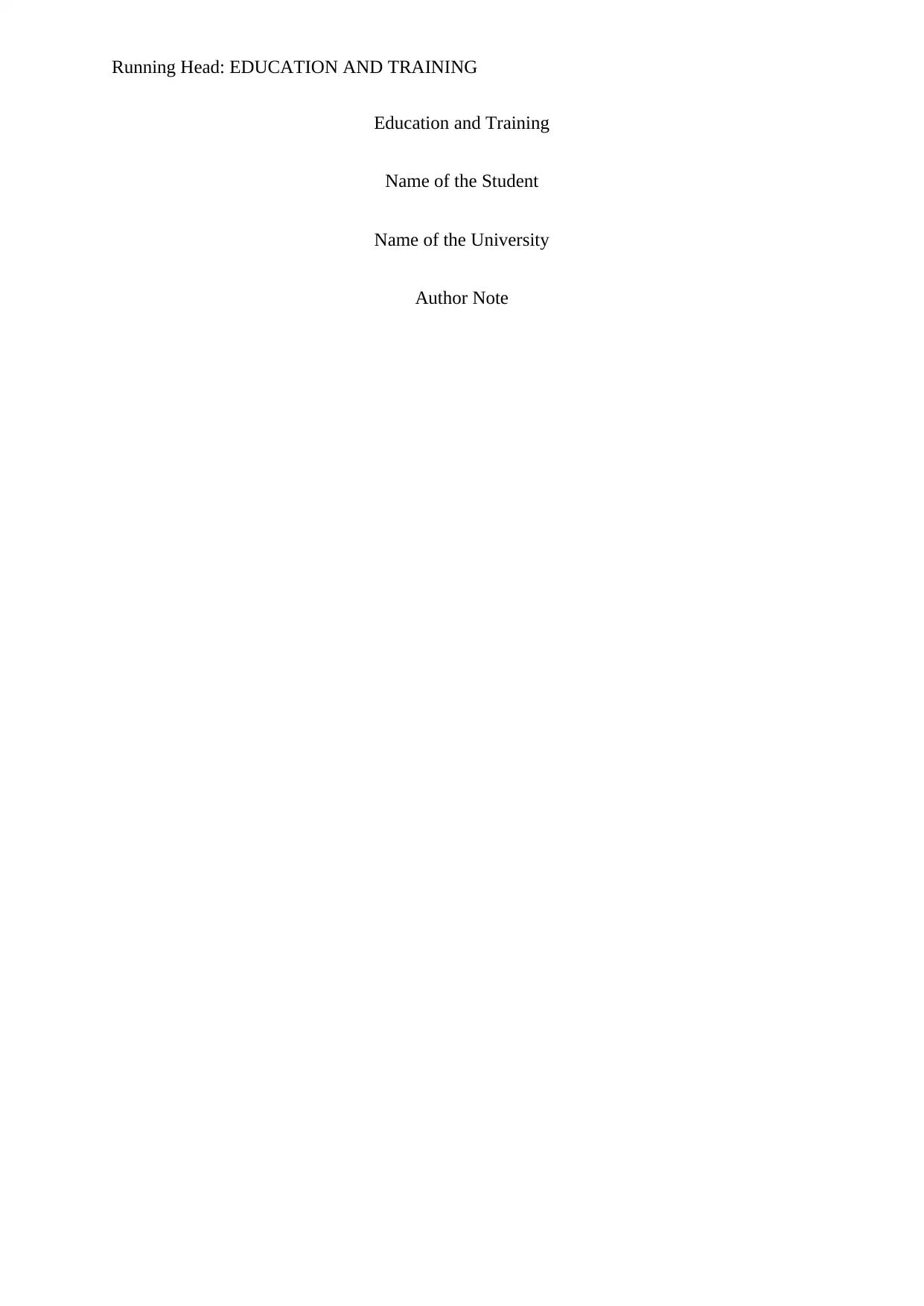
Running Head: EDUCATION AND TRAINING
Education and Training
Name of the Student
Name of the University
Author Note
Education and Training
Name of the Student
Name of the University
Author Note
Paraphrase This Document
Need a fresh take? Get an instant paraphrase of this document with our AI Paraphraser
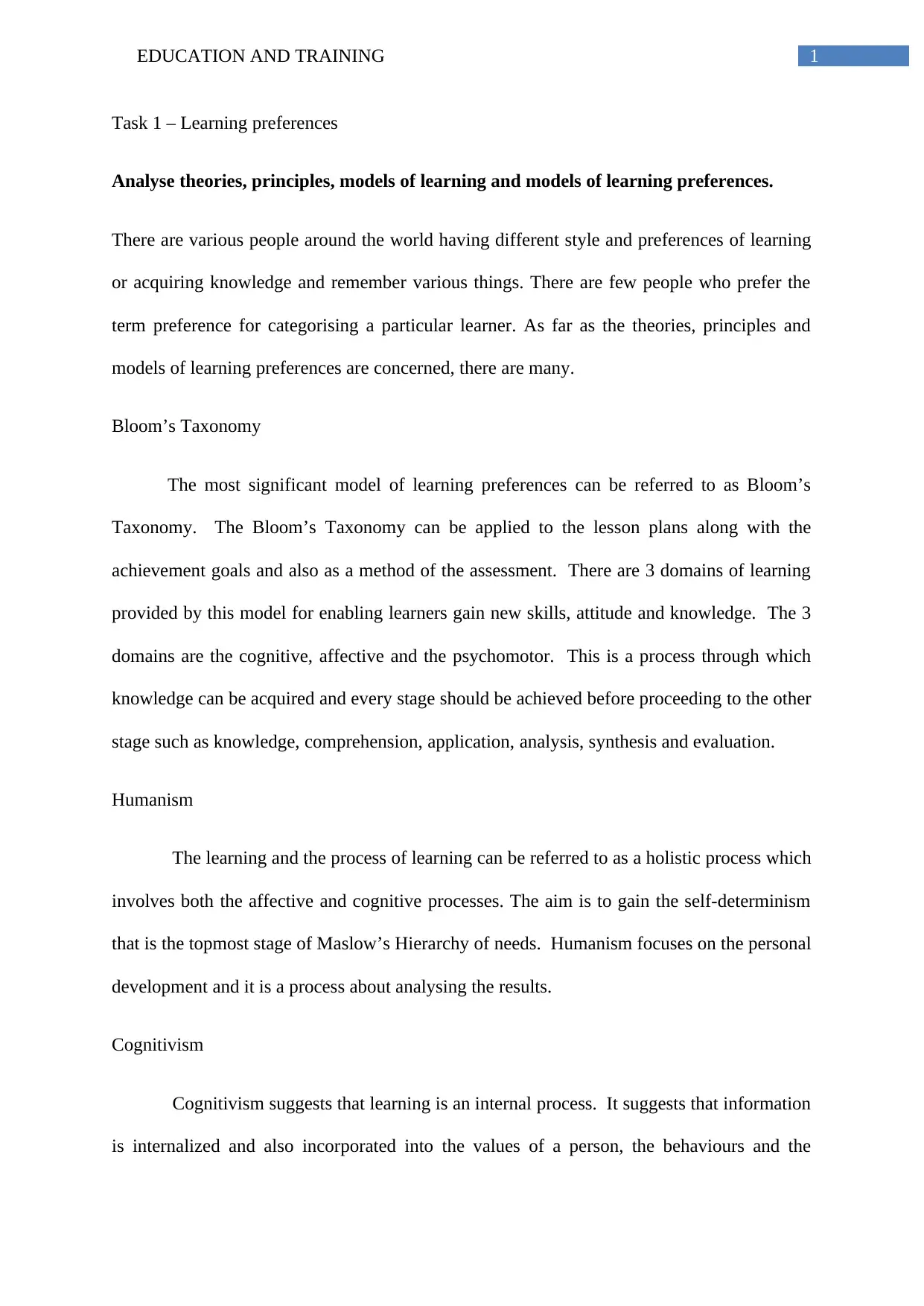
1EDUCATION AND TRAINING
Task 1 – Learning preferences
Analyse theories, principles, models of learning and models of learning preferences.
There are various people around the world having different style and preferences of learning
or acquiring knowledge and remember various things. There are few people who prefer the
term preference for categorising a particular learner. As far as the theories, principles and
models of learning preferences are concerned, there are many.
Bloom’s Taxonomy
The most significant model of learning preferences can be referred to as Bloom’s
Taxonomy. The Bloom’s Taxonomy can be applied to the lesson plans along with the
achievement goals and also as a method of the assessment. There are 3 domains of learning
provided by this model for enabling learners gain new skills, attitude and knowledge. The 3
domains are the cognitive, affective and the psychomotor. This is a process through which
knowledge can be acquired and every stage should be achieved before proceeding to the other
stage such as knowledge, comprehension, application, analysis, synthesis and evaluation.
Humanism
The learning and the process of learning can be referred to as a holistic process which
involves both the affective and cognitive processes. The aim is to gain the self-determinism
that is the topmost stage of Maslow’s Hierarchy of needs. Humanism focuses on the personal
development and it is a process about analysing the results.
Cognitivism
Cognitivism suggests that learning is an internal process. It suggests that information
is internalized and also incorporated into the values of a person, the behaviours and the
Task 1 – Learning preferences
Analyse theories, principles, models of learning and models of learning preferences.
There are various people around the world having different style and preferences of learning
or acquiring knowledge and remember various things. There are few people who prefer the
term preference for categorising a particular learner. As far as the theories, principles and
models of learning preferences are concerned, there are many.
Bloom’s Taxonomy
The most significant model of learning preferences can be referred to as Bloom’s
Taxonomy. The Bloom’s Taxonomy can be applied to the lesson plans along with the
achievement goals and also as a method of the assessment. There are 3 domains of learning
provided by this model for enabling learners gain new skills, attitude and knowledge. The 3
domains are the cognitive, affective and the psychomotor. This is a process through which
knowledge can be acquired and every stage should be achieved before proceeding to the other
stage such as knowledge, comprehension, application, analysis, synthesis and evaluation.
Humanism
The learning and the process of learning can be referred to as a holistic process which
involves both the affective and cognitive processes. The aim is to gain the self-determinism
that is the topmost stage of Maslow’s Hierarchy of needs. Humanism focuses on the personal
development and it is a process about analysing the results.
Cognitivism
Cognitivism suggests that learning is an internal process. It suggests that information
is internalized and also incorporated into the values of a person, the behaviours and the
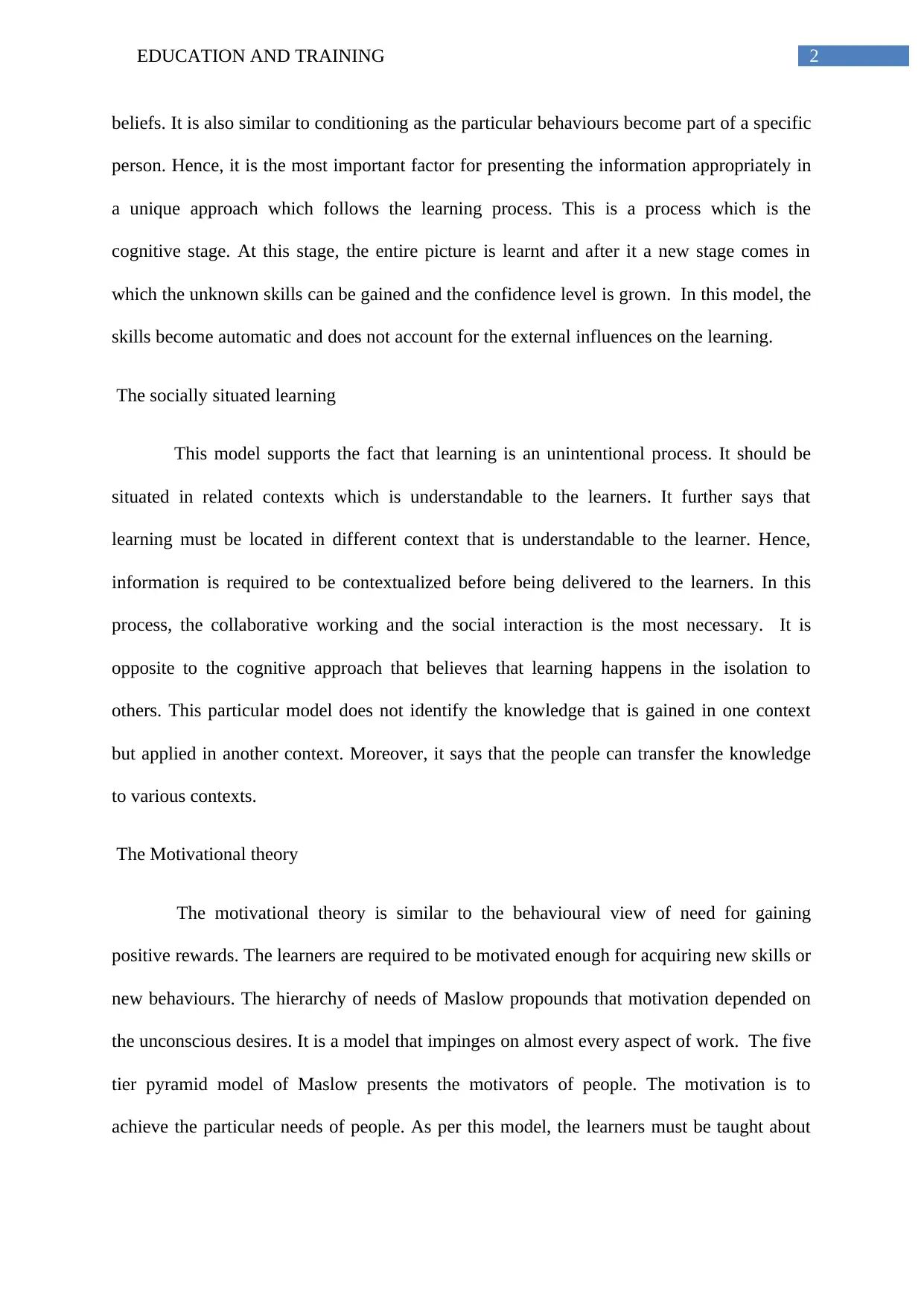
2EDUCATION AND TRAINING
beliefs. It is also similar to conditioning as the particular behaviours become part of a specific
person. Hence, it is the most important factor for presenting the information appropriately in
a unique approach which follows the learning process. This is a process which is the
cognitive stage. At this stage, the entire picture is learnt and after it a new stage comes in
which the unknown skills can be gained and the confidence level is grown. In this model, the
skills become automatic and does not account for the external influences on the learning.
The socially situated learning
This model supports the fact that learning is an unintentional process. It should be
situated in related contexts which is understandable to the learners. It further says that
learning must be located in different context that is understandable to the learner. Hence,
information is required to be contextualized before being delivered to the learners. In this
process, the collaborative working and the social interaction is the most necessary. It is
opposite to the cognitive approach that believes that learning happens in the isolation to
others. This particular model does not identify the knowledge that is gained in one context
but applied in another context. Moreover, it says that the people can transfer the knowledge
to various contexts.
The Motivational theory
The motivational theory is similar to the behavioural view of need for gaining
positive rewards. The learners are required to be motivated enough for acquiring new skills or
new behaviours. The hierarchy of needs of Maslow propounds that motivation depended on
the unconscious desires. It is a model that impinges on almost every aspect of work. The five
tier pyramid model of Maslow presents the motivators of people. The motivation is to
achieve the particular needs of people. As per this model, the learners must be taught about
beliefs. It is also similar to conditioning as the particular behaviours become part of a specific
person. Hence, it is the most important factor for presenting the information appropriately in
a unique approach which follows the learning process. This is a process which is the
cognitive stage. At this stage, the entire picture is learnt and after it a new stage comes in
which the unknown skills can be gained and the confidence level is grown. In this model, the
skills become automatic and does not account for the external influences on the learning.
The socially situated learning
This model supports the fact that learning is an unintentional process. It should be
situated in related contexts which is understandable to the learners. It further says that
learning must be located in different context that is understandable to the learner. Hence,
information is required to be contextualized before being delivered to the learners. In this
process, the collaborative working and the social interaction is the most necessary. It is
opposite to the cognitive approach that believes that learning happens in the isolation to
others. This particular model does not identify the knowledge that is gained in one context
but applied in another context. Moreover, it says that the people can transfer the knowledge
to various contexts.
The Motivational theory
The motivational theory is similar to the behavioural view of need for gaining
positive rewards. The learners are required to be motivated enough for acquiring new skills or
new behaviours. The hierarchy of needs of Maslow propounds that motivation depended on
the unconscious desires. It is a model that impinges on almost every aspect of work. The five
tier pyramid model of Maslow presents the motivators of people. The motivation is to
achieve the particular needs of people. As per this model, the learners must be taught about
⊘ This is a preview!⊘
Do you want full access?
Subscribe today to unlock all pages.

Trusted by 1+ million students worldwide
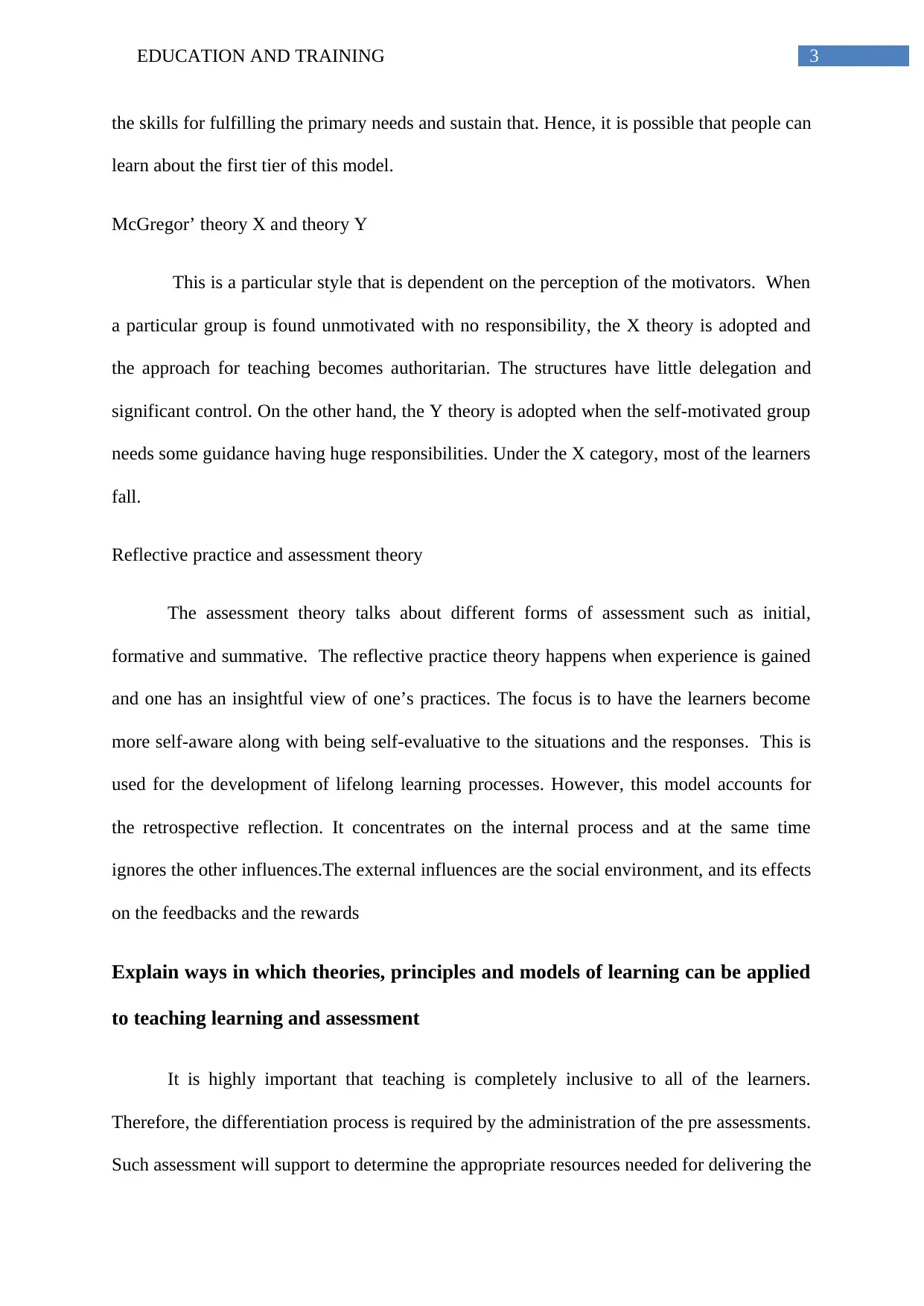
3EDUCATION AND TRAINING
the skills for fulfilling the primary needs and sustain that. Hence, it is possible that people can
learn about the first tier of this model.
McGregor’ theory X and theory Y
This is a particular style that is dependent on the perception of the motivators. When
a particular group is found unmotivated with no responsibility, the X theory is adopted and
the approach for teaching becomes authoritarian. The structures have little delegation and
significant control. On the other hand, the Y theory is adopted when the self-motivated group
needs some guidance having huge responsibilities. Under the X category, most of the learners
fall.
Reflective practice and assessment theory
The assessment theory talks about different forms of assessment such as initial,
formative and summative. The reflective practice theory happens when experience is gained
and one has an insightful view of one’s practices. The focus is to have the learners become
more self-aware along with being self-evaluative to the situations and the responses. This is
used for the development of lifelong learning processes. However, this model accounts for
the retrospective reflection. It concentrates on the internal process and at the same time
ignores the other influences.The external influences are the social environment, and its effects
on the feedbacks and the rewards
Explain ways in which theories, principles and models of learning can be applied
to teaching learning and assessment
It is highly important that teaching is completely inclusive to all of the learners.
Therefore, the differentiation process is required by the administration of the pre assessments.
Such assessment will support to determine the appropriate resources needed for delivering the
the skills for fulfilling the primary needs and sustain that. Hence, it is possible that people can
learn about the first tier of this model.
McGregor’ theory X and theory Y
This is a particular style that is dependent on the perception of the motivators. When
a particular group is found unmotivated with no responsibility, the X theory is adopted and
the approach for teaching becomes authoritarian. The structures have little delegation and
significant control. On the other hand, the Y theory is adopted when the self-motivated group
needs some guidance having huge responsibilities. Under the X category, most of the learners
fall.
Reflective practice and assessment theory
The assessment theory talks about different forms of assessment such as initial,
formative and summative. The reflective practice theory happens when experience is gained
and one has an insightful view of one’s practices. The focus is to have the learners become
more self-aware along with being self-evaluative to the situations and the responses. This is
used for the development of lifelong learning processes. However, this model accounts for
the retrospective reflection. It concentrates on the internal process and at the same time
ignores the other influences.The external influences are the social environment, and its effects
on the feedbacks and the rewards
Explain ways in which theories, principles and models of learning can be applied
to teaching learning and assessment
It is highly important that teaching is completely inclusive to all of the learners.
Therefore, the differentiation process is required by the administration of the pre assessments.
Such assessment will support to determine the appropriate resources needed for delivering the
Paraphrase This Document
Need a fresh take? Get an instant paraphrase of this document with our AI Paraphraser
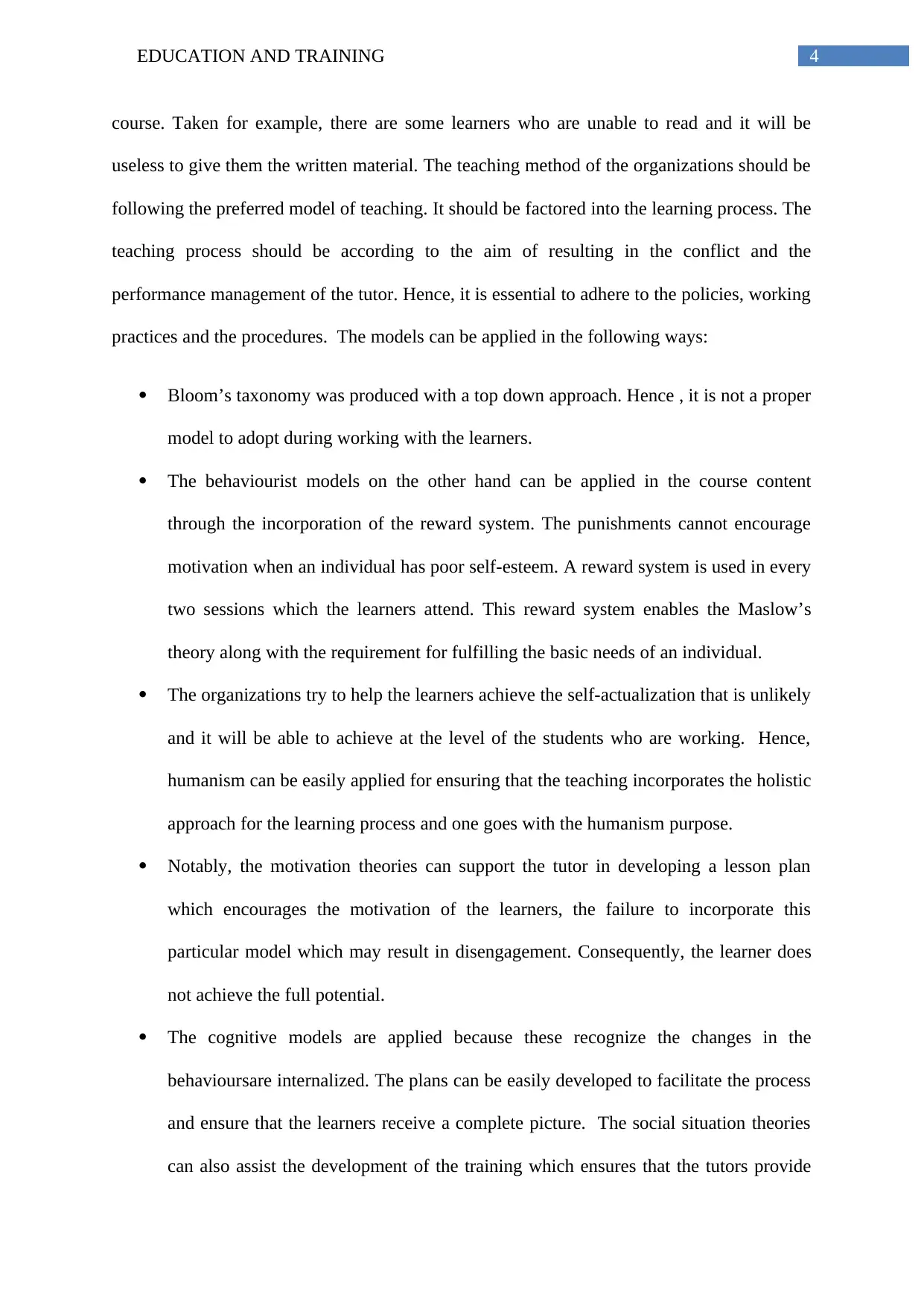
4EDUCATION AND TRAINING
course. Taken for example, there are some learners who are unable to read and it will be
useless to give them the written material. The teaching method of the organizations should be
following the preferred model of teaching. It should be factored into the learning process. The
teaching process should be according to the aim of resulting in the conflict and the
performance management of the tutor. Hence, it is essential to adhere to the policies, working
practices and the procedures. The models can be applied in the following ways:
Bloom’s taxonomy was produced with a top down approach. Hence , it is not a proper
model to adopt during working with the learners.
The behaviourist models on the other hand can be applied in the course content
through the incorporation of the reward system. The punishments cannot encourage
motivation when an individual has poor self-esteem. A reward system is used in every
two sessions which the learners attend. This reward system enables the Maslow’s
theory along with the requirement for fulfilling the basic needs of an individual.
The organizations try to help the learners achieve the self-actualization that is unlikely
and it will be able to achieve at the level of the students who are working. Hence,
humanism can be easily applied for ensuring that the teaching incorporates the holistic
approach for the learning process and one goes with the humanism purpose.
Notably, the motivation theories can support the tutor in developing a lesson plan
which encourages the motivation of the learners, the failure to incorporate this
particular model which may result in disengagement. Consequently, the learner does
not achieve the full potential.
The cognitive models are applied because these recognize the changes in the
behavioursare internalized. The plans can be easily developed to facilitate the process
and ensure that the learners receive a complete picture. The social situation theories
can also assist the development of the training which ensures that the tutors provide
course. Taken for example, there are some learners who are unable to read and it will be
useless to give them the written material. The teaching method of the organizations should be
following the preferred model of teaching. It should be factored into the learning process. The
teaching process should be according to the aim of resulting in the conflict and the
performance management of the tutor. Hence, it is essential to adhere to the policies, working
practices and the procedures. The models can be applied in the following ways:
Bloom’s taxonomy was produced with a top down approach. Hence , it is not a proper
model to adopt during working with the learners.
The behaviourist models on the other hand can be applied in the course content
through the incorporation of the reward system. The punishments cannot encourage
motivation when an individual has poor self-esteem. A reward system is used in every
two sessions which the learners attend. This reward system enables the Maslow’s
theory along with the requirement for fulfilling the basic needs of an individual.
The organizations try to help the learners achieve the self-actualization that is unlikely
and it will be able to achieve at the level of the students who are working. Hence,
humanism can be easily applied for ensuring that the teaching incorporates the holistic
approach for the learning process and one goes with the humanism purpose.
Notably, the motivation theories can support the tutor in developing a lesson plan
which encourages the motivation of the learners, the failure to incorporate this
particular model which may result in disengagement. Consequently, the learner does
not achieve the full potential.
The cognitive models are applied because these recognize the changes in the
behavioursare internalized. The plans can be easily developed to facilitate the process
and ensure that the learners receive a complete picture. The social situation theories
can also assist the development of the training which ensures that the tutors provide
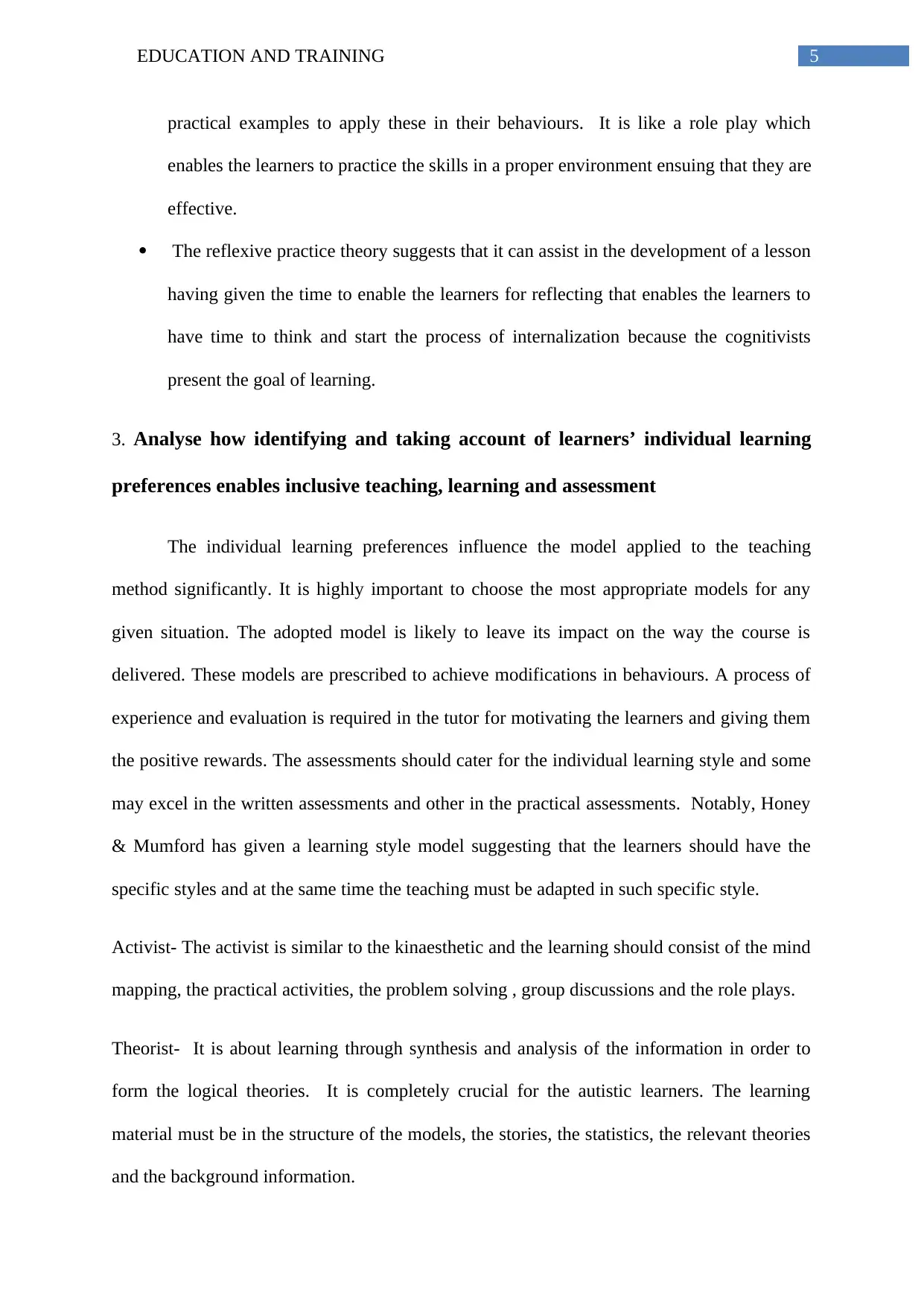
5EDUCATION AND TRAINING
practical examples to apply these in their behaviours. It is like a role play which
enables the learners to practice the skills in a proper environment ensuing that they are
effective.
The reflexive practice theory suggests that it can assist in the development of a lesson
having given the time to enable the learners for reflecting that enables the learners to
have time to think and start the process of internalization because the cognitivists
present the goal of learning.
3. Analyse how identifying and taking account of learners’ individual learning
preferences enables inclusive teaching, learning and assessment
The individual learning preferences influence the model applied to the teaching
method significantly. It is highly important to choose the most appropriate models for any
given situation. The adopted model is likely to leave its impact on the way the course is
delivered. These models are prescribed to achieve modifications in behaviours. A process of
experience and evaluation is required in the tutor for motivating the learners and giving them
the positive rewards. The assessments should cater for the individual learning style and some
may excel in the written assessments and other in the practical assessments. Notably, Honey
& Mumford has given a learning style model suggesting that the learners should have the
specific styles and at the same time the teaching must be adapted in such specific style.
Activist- The activist is similar to the kinaesthetic and the learning should consist of the mind
mapping, the practical activities, the problem solving , group discussions and the role plays.
Theorist- It is about learning through synthesis and analysis of the information in order to
form the logical theories. It is completely crucial for the autistic learners. The learning
material must be in the structure of the models, the stories, the statistics, the relevant theories
and the background information.
practical examples to apply these in their behaviours. It is like a role play which
enables the learners to practice the skills in a proper environment ensuing that they are
effective.
The reflexive practice theory suggests that it can assist in the development of a lesson
having given the time to enable the learners for reflecting that enables the learners to
have time to think and start the process of internalization because the cognitivists
present the goal of learning.
3. Analyse how identifying and taking account of learners’ individual learning
preferences enables inclusive teaching, learning and assessment
The individual learning preferences influence the model applied to the teaching
method significantly. It is highly important to choose the most appropriate models for any
given situation. The adopted model is likely to leave its impact on the way the course is
delivered. These models are prescribed to achieve modifications in behaviours. A process of
experience and evaluation is required in the tutor for motivating the learners and giving them
the positive rewards. The assessments should cater for the individual learning style and some
may excel in the written assessments and other in the practical assessments. Notably, Honey
& Mumford has given a learning style model suggesting that the learners should have the
specific styles and at the same time the teaching must be adapted in such specific style.
Activist- The activist is similar to the kinaesthetic and the learning should consist of the mind
mapping, the practical activities, the problem solving , group discussions and the role plays.
Theorist- It is about learning through synthesis and analysis of the information in order to
form the logical theories. It is completely crucial for the autistic learners. The learning
material must be in the structure of the models, the stories, the statistics, the relevant theories
and the background information.
⊘ This is a preview!⊘
Do you want full access?
Subscribe today to unlock all pages.

Trusted by 1+ million students worldwide
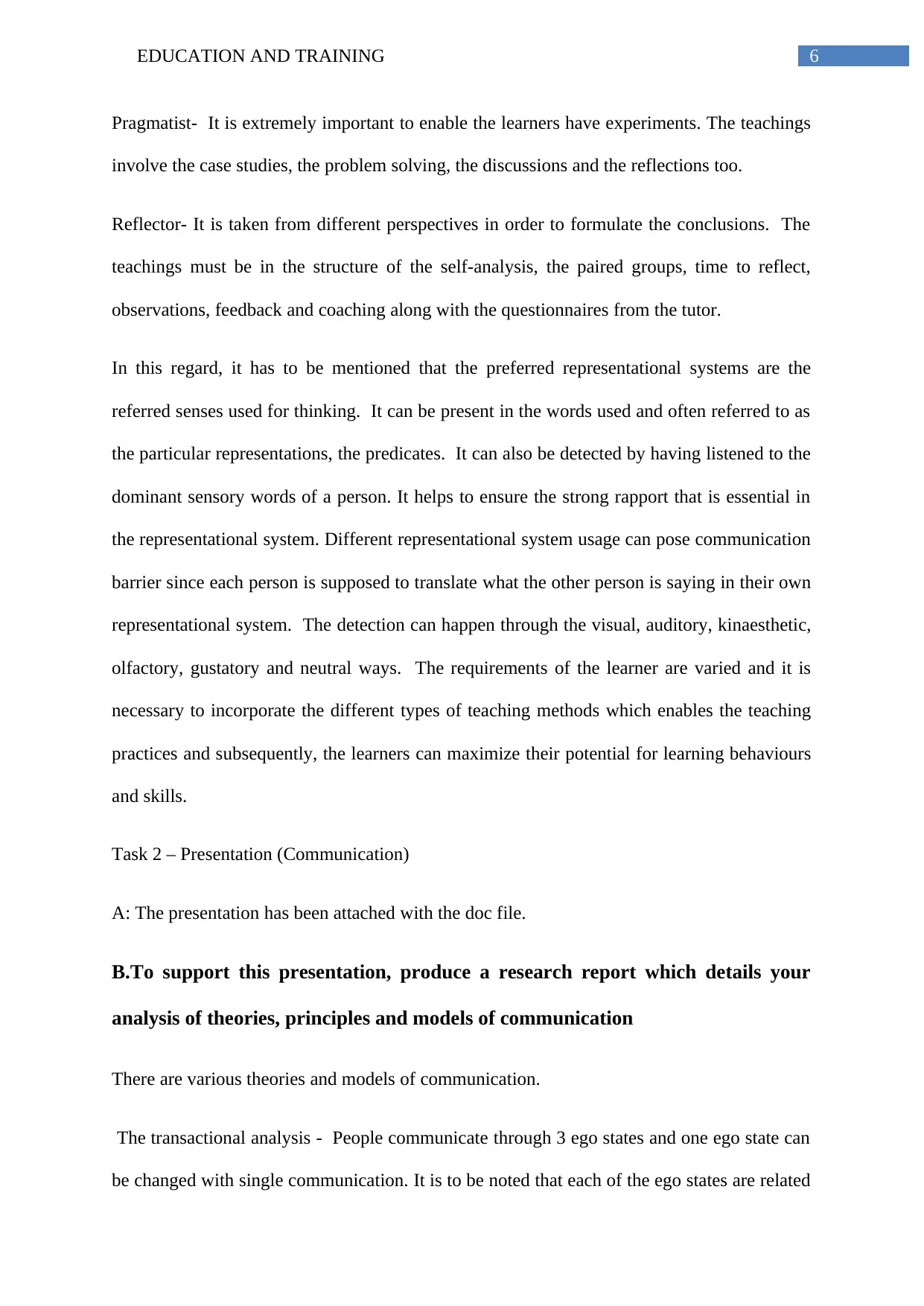
6EDUCATION AND TRAINING
Pragmatist- It is extremely important to enable the learners have experiments. The teachings
involve the case studies, the problem solving, the discussions and the reflections too.
Reflector- It is taken from different perspectives in order to formulate the conclusions. The
teachings must be in the structure of the self-analysis, the paired groups, time to reflect,
observations, feedback and coaching along with the questionnaires from the tutor.
In this regard, it has to be mentioned that the preferred representational systems are the
referred senses used for thinking. It can be present in the words used and often referred to as
the particular representations, the predicates. It can also be detected by having listened to the
dominant sensory words of a person. It helps to ensure the strong rapport that is essential in
the representational system. Different representational system usage can pose communication
barrier since each person is supposed to translate what the other person is saying in their own
representational system. The detection can happen through the visual, auditory, kinaesthetic,
olfactory, gustatory and neutral ways. The requirements of the learner are varied and it is
necessary to incorporate the different types of teaching methods which enables the teaching
practices and subsequently, the learners can maximize their potential for learning behaviours
and skills.
Task 2 – Presentation (Communication)
A: The presentation has been attached with the doc file.
B.To support this presentation, produce a research report which details your
analysis of theories, principles and models of communication
There are various theories and models of communication.
The transactional analysis - People communicate through 3 ego states and one ego state can
be changed with single communication. It is to be noted that each of the ego states are related
Pragmatist- It is extremely important to enable the learners have experiments. The teachings
involve the case studies, the problem solving, the discussions and the reflections too.
Reflector- It is taken from different perspectives in order to formulate the conclusions. The
teachings must be in the structure of the self-analysis, the paired groups, time to reflect,
observations, feedback and coaching along with the questionnaires from the tutor.
In this regard, it has to be mentioned that the preferred representational systems are the
referred senses used for thinking. It can be present in the words used and often referred to as
the particular representations, the predicates. It can also be detected by having listened to the
dominant sensory words of a person. It helps to ensure the strong rapport that is essential in
the representational system. Different representational system usage can pose communication
barrier since each person is supposed to translate what the other person is saying in their own
representational system. The detection can happen through the visual, auditory, kinaesthetic,
olfactory, gustatory and neutral ways. The requirements of the learner are varied and it is
necessary to incorporate the different types of teaching methods which enables the teaching
practices and subsequently, the learners can maximize their potential for learning behaviours
and skills.
Task 2 – Presentation (Communication)
A: The presentation has been attached with the doc file.
B.To support this presentation, produce a research report which details your
analysis of theories, principles and models of communication
There are various theories and models of communication.
The transactional analysis - People communicate through 3 ego states and one ego state can
be changed with single communication. It is to be noted that each of the ego states are related
Paraphrase This Document
Need a fresh take? Get an instant paraphrase of this document with our AI Paraphraser
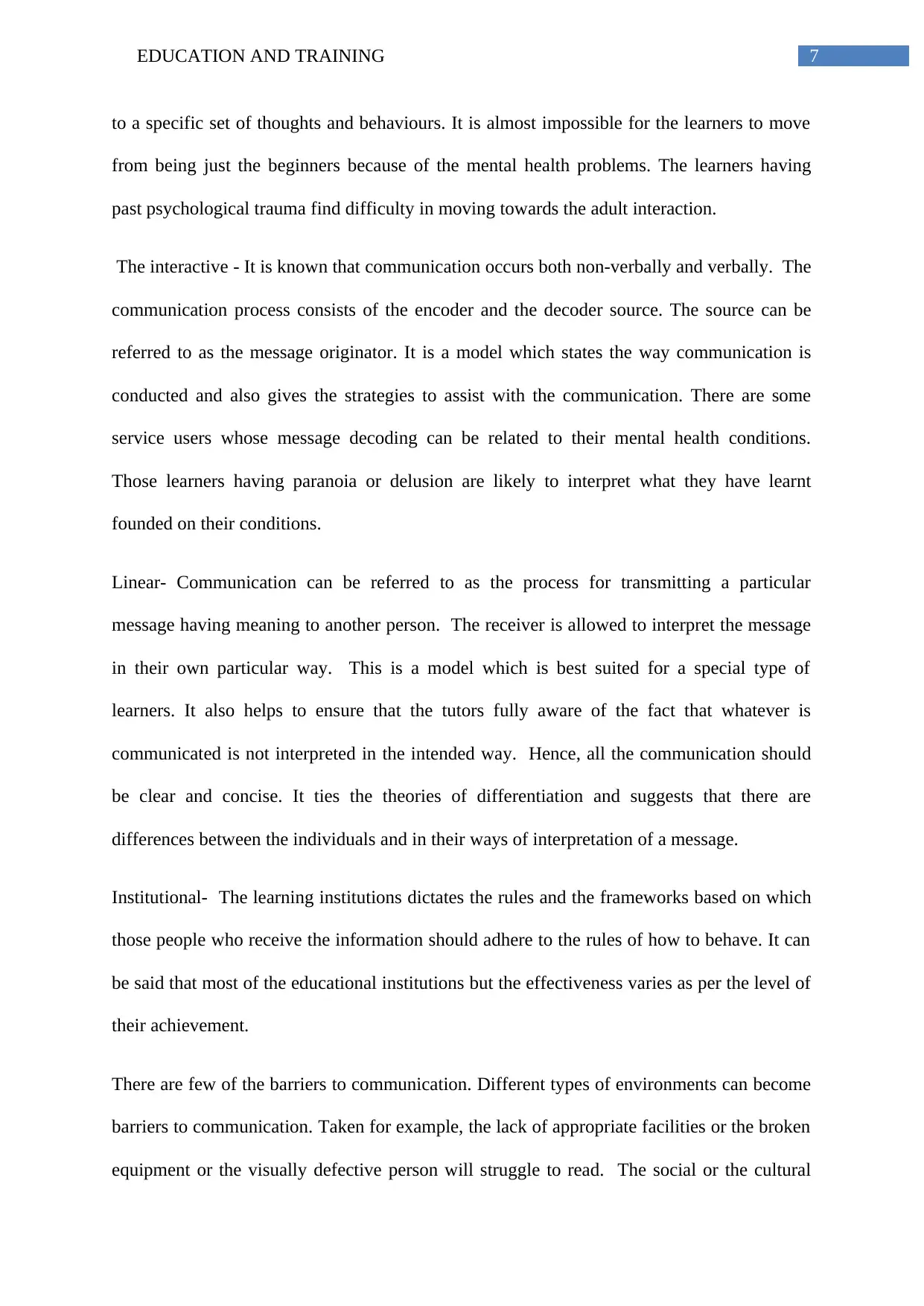
7EDUCATION AND TRAINING
to a specific set of thoughts and behaviours. It is almost impossible for the learners to move
from being just the beginners because of the mental health problems. The learners having
past psychological trauma find difficulty in moving towards the adult interaction.
The interactive - It is known that communication occurs both non-verbally and verbally. The
communication process consists of the encoder and the decoder source. The source can be
referred to as the message originator. It is a model which states the way communication is
conducted and also gives the strategies to assist with the communication. There are some
service users whose message decoding can be related to their mental health conditions.
Those learners having paranoia or delusion are likely to interpret what they have learnt
founded on their conditions.
Linear- Communication can be referred to as the process for transmitting a particular
message having meaning to another person. The receiver is allowed to interpret the message
in their own particular way. This is a model which is best suited for a special type of
learners. It also helps to ensure that the tutors fully aware of the fact that whatever is
communicated is not interpreted in the intended way. Hence, all the communication should
be clear and concise. It ties the theories of differentiation and suggests that there are
differences between the individuals and in their ways of interpretation of a message.
Institutional- The learning institutions dictates the rules and the frameworks based on which
those people who receive the information should adhere to the rules of how to behave. It can
be said that most of the educational institutions but the effectiveness varies as per the level of
their achievement.
There are few of the barriers to communication. Different types of environments can become
barriers to communication. Taken for example, the lack of appropriate facilities or the broken
equipment or the visually defective person will struggle to read. The social or the cultural
to a specific set of thoughts and behaviours. It is almost impossible for the learners to move
from being just the beginners because of the mental health problems. The learners having
past psychological trauma find difficulty in moving towards the adult interaction.
The interactive - It is known that communication occurs both non-verbally and verbally. The
communication process consists of the encoder and the decoder source. The source can be
referred to as the message originator. It is a model which states the way communication is
conducted and also gives the strategies to assist with the communication. There are some
service users whose message decoding can be related to their mental health conditions.
Those learners having paranoia or delusion are likely to interpret what they have learnt
founded on their conditions.
Linear- Communication can be referred to as the process for transmitting a particular
message having meaning to another person. The receiver is allowed to interpret the message
in their own particular way. This is a model which is best suited for a special type of
learners. It also helps to ensure that the tutors fully aware of the fact that whatever is
communicated is not interpreted in the intended way. Hence, all the communication should
be clear and concise. It ties the theories of differentiation and suggests that there are
differences between the individuals and in their ways of interpretation of a message.
Institutional- The learning institutions dictates the rules and the frameworks based on which
those people who receive the information should adhere to the rules of how to behave. It can
be said that most of the educational institutions but the effectiveness varies as per the level of
their achievement.
There are few of the barriers to communication. Different types of environments can become
barriers to communication. Taken for example, the lack of appropriate facilities or the broken
equipment or the visually defective person will struggle to read. The social or the cultural
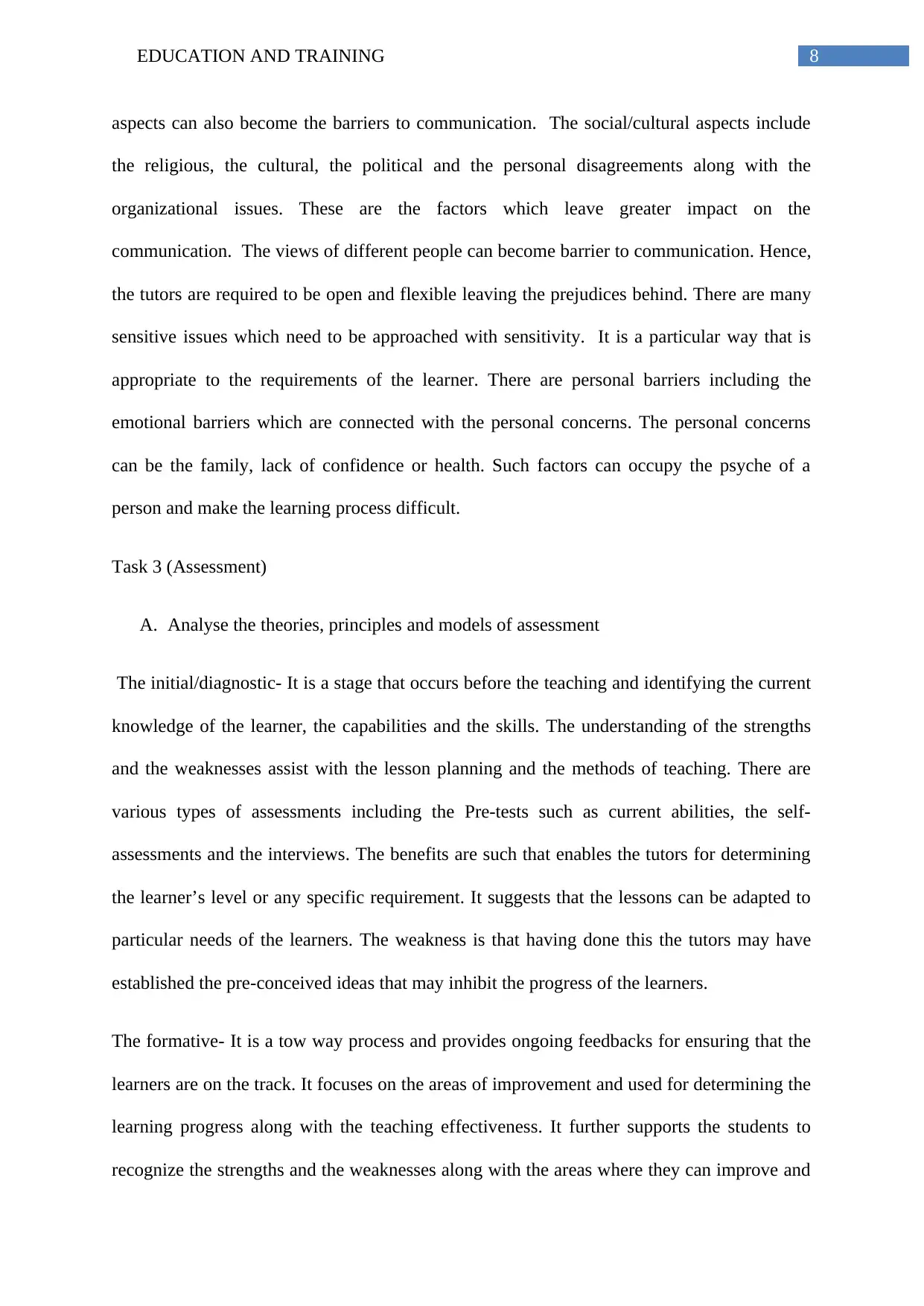
8EDUCATION AND TRAINING
aspects can also become the barriers to communication. The social/cultural aspects include
the religious, the cultural, the political and the personal disagreements along with the
organizational issues. These are the factors which leave greater impact on the
communication. The views of different people can become barrier to communication. Hence,
the tutors are required to be open and flexible leaving the prejudices behind. There are many
sensitive issues which need to be approached with sensitivity. It is a particular way that is
appropriate to the requirements of the learner. There are personal barriers including the
emotional barriers which are connected with the personal concerns. The personal concerns
can be the family, lack of confidence or health. Such factors can occupy the psyche of a
person and make the learning process difficult.
Task 3 (Assessment)
A. Analyse the theories, principles and models of assessment
The initial/diagnostic- It is a stage that occurs before the teaching and identifying the current
knowledge of the learner, the capabilities and the skills. The understanding of the strengths
and the weaknesses assist with the lesson planning and the methods of teaching. There are
various types of assessments including the Pre-tests such as current abilities, the self-
assessments and the interviews. The benefits are such that enables the tutors for determining
the learner’s level or any specific requirement. It suggests that the lessons can be adapted to
particular needs of the learners. The weakness is that having done this the tutors may have
established the pre-conceived ideas that may inhibit the progress of the learners.
The formative- It is a tow way process and provides ongoing feedbacks for ensuring that the
learners are on the track. It focuses on the areas of improvement and used for determining the
learning progress along with the teaching effectiveness. It further supports the students to
recognize the strengths and the weaknesses along with the areas where they can improve and
aspects can also become the barriers to communication. The social/cultural aspects include
the religious, the cultural, the political and the personal disagreements along with the
organizational issues. These are the factors which leave greater impact on the
communication. The views of different people can become barrier to communication. Hence,
the tutors are required to be open and flexible leaving the prejudices behind. There are many
sensitive issues which need to be approached with sensitivity. It is a particular way that is
appropriate to the requirements of the learner. There are personal barriers including the
emotional barriers which are connected with the personal concerns. The personal concerns
can be the family, lack of confidence or health. Such factors can occupy the psyche of a
person and make the learning process difficult.
Task 3 (Assessment)
A. Analyse the theories, principles and models of assessment
The initial/diagnostic- It is a stage that occurs before the teaching and identifying the current
knowledge of the learner, the capabilities and the skills. The understanding of the strengths
and the weaknesses assist with the lesson planning and the methods of teaching. There are
various types of assessments including the Pre-tests such as current abilities, the self-
assessments and the interviews. The benefits are such that enables the tutors for determining
the learner’s level or any specific requirement. It suggests that the lessons can be adapted to
particular needs of the learners. The weakness is that having done this the tutors may have
established the pre-conceived ideas that may inhibit the progress of the learners.
The formative- It is a tow way process and provides ongoing feedbacks for ensuring that the
learners are on the track. It focuses on the areas of improvement and used for determining the
learning progress along with the teaching effectiveness. It further supports the students to
recognize the strengths and the weaknesses along with the areas where they can improve and
⊘ This is a preview!⊘
Do you want full access?
Subscribe today to unlock all pages.

Trusted by 1+ million students worldwide
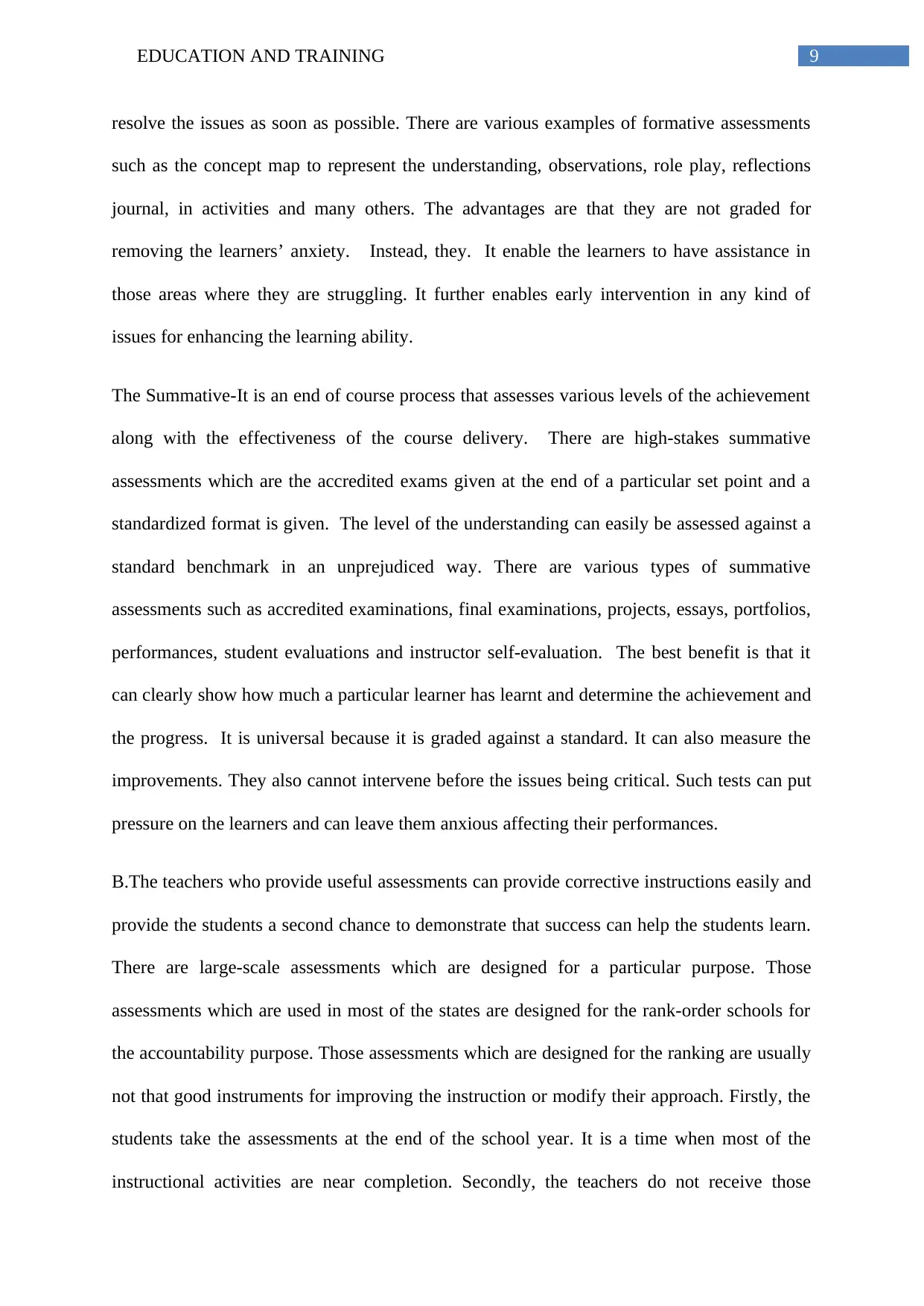
9EDUCATION AND TRAINING
resolve the issues as soon as possible. There are various examples of formative assessments
such as the concept map to represent the understanding, observations, role play, reflections
journal, in activities and many others. The advantages are that they are not graded for
removing the learners’ anxiety. Instead, they. It enable the learners to have assistance in
those areas where they are struggling. It further enables early intervention in any kind of
issues for enhancing the learning ability.
The Summative-It is an end of course process that assesses various levels of the achievement
along with the effectiveness of the course delivery. There are high-stakes summative
assessments which are the accredited exams given at the end of a particular set point and a
standardized format is given. The level of the understanding can easily be assessed against a
standard benchmark in an unprejudiced way. There are various types of summative
assessments such as accredited examinations, final examinations, projects, essays, portfolios,
performances, student evaluations and instructor self-evaluation. The best benefit is that it
can clearly show how much a particular learner has learnt and determine the achievement and
the progress. It is universal because it is graded against a standard. It can also measure the
improvements. They also cannot intervene before the issues being critical. Such tests can put
pressure on the learners and can leave them anxious affecting their performances.
B.The teachers who provide useful assessments can provide corrective instructions easily and
provide the students a second chance to demonstrate that success can help the students learn.
There are large-scale assessments which are designed for a particular purpose. Those
assessments which are used in most of the states are designed for the rank-order schools for
the accountability purpose. Those assessments which are designed for the ranking are usually
not that good instruments for improving the instruction or modify their approach. Firstly, the
students take the assessments at the end of the school year. It is a time when most of the
instructional activities are near completion. Secondly, the teachers do not receive those
resolve the issues as soon as possible. There are various examples of formative assessments
such as the concept map to represent the understanding, observations, role play, reflections
journal, in activities and many others. The advantages are that they are not graded for
removing the learners’ anxiety. Instead, they. It enable the learners to have assistance in
those areas where they are struggling. It further enables early intervention in any kind of
issues for enhancing the learning ability.
The Summative-It is an end of course process that assesses various levels of the achievement
along with the effectiveness of the course delivery. There are high-stakes summative
assessments which are the accredited exams given at the end of a particular set point and a
standardized format is given. The level of the understanding can easily be assessed against a
standard benchmark in an unprejudiced way. There are various types of summative
assessments such as accredited examinations, final examinations, projects, essays, portfolios,
performances, student evaluations and instructor self-evaluation. The best benefit is that it
can clearly show how much a particular learner has learnt and determine the achievement and
the progress. It is universal because it is graded against a standard. It can also measure the
improvements. They also cannot intervene before the issues being critical. Such tests can put
pressure on the learners and can leave them anxious affecting their performances.
B.The teachers who provide useful assessments can provide corrective instructions easily and
provide the students a second chance to demonstrate that success can help the students learn.
There are large-scale assessments which are designed for a particular purpose. Those
assessments which are used in most of the states are designed for the rank-order schools for
the accountability purpose. Those assessments which are designed for the ranking are usually
not that good instruments for improving the instruction or modify their approach. Firstly, the
students take the assessments at the end of the school year. It is a time when most of the
instructional activities are near completion. Secondly, the teachers do not receive those
Paraphrase This Document
Need a fresh take? Get an instant paraphrase of this document with our AI Paraphraser
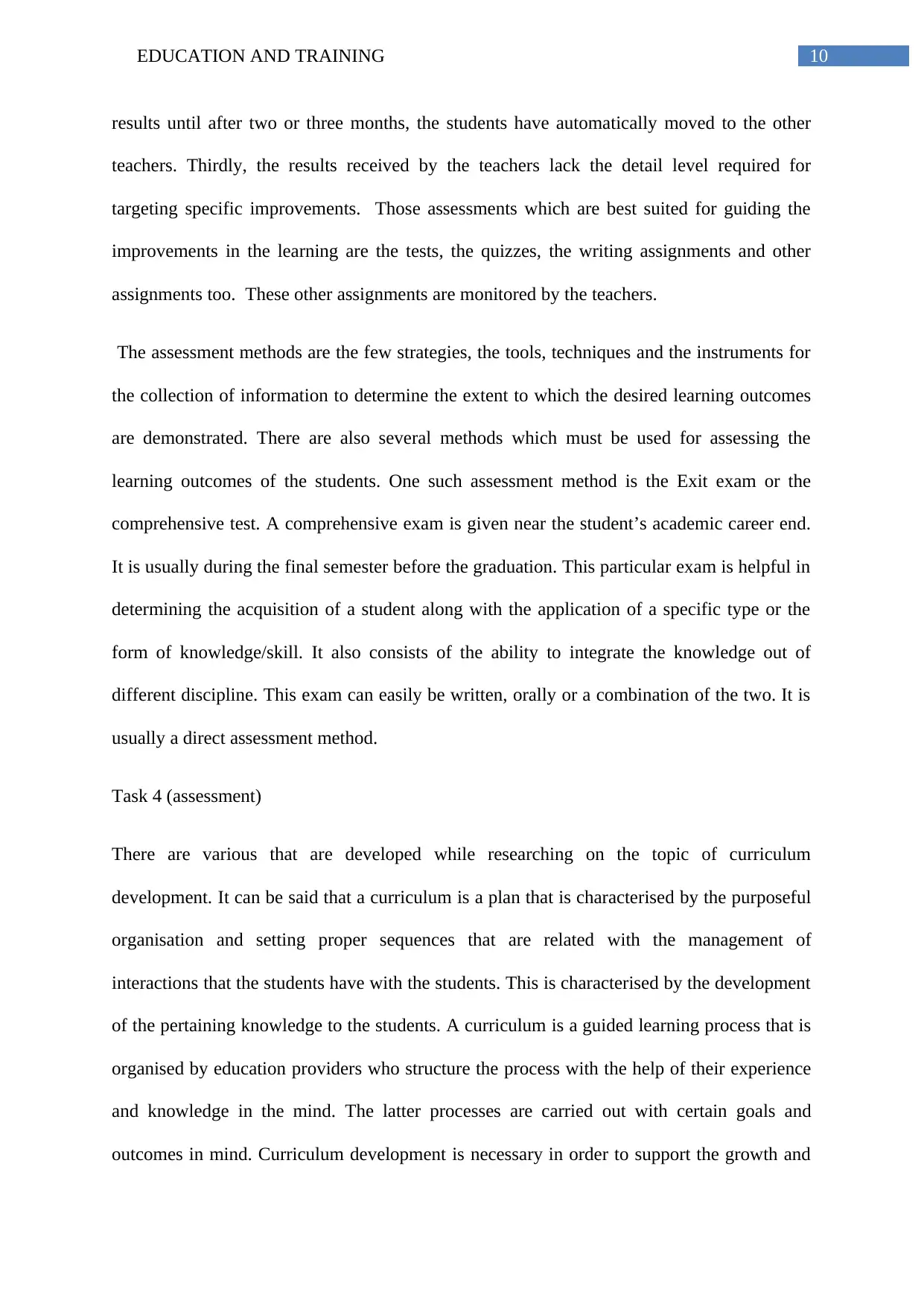
10EDUCATION AND TRAINING
results until after two or three months, the students have automatically moved to the other
teachers. Thirdly, the results received by the teachers lack the detail level required for
targeting specific improvements. Those assessments which are best suited for guiding the
improvements in the learning are the tests, the quizzes, the writing assignments and other
assignments too. These other assignments are monitored by the teachers.
The assessment methods are the few strategies, the tools, techniques and the instruments for
the collection of information to determine the extent to which the desired learning outcomes
are demonstrated. There are also several methods which must be used for assessing the
learning outcomes of the students. One such assessment method is the Exit exam or the
comprehensive test. A comprehensive exam is given near the student’s academic career end.
It is usually during the final semester before the graduation. This particular exam is helpful in
determining the acquisition of a student along with the application of a specific type or the
form of knowledge/skill. It also consists of the ability to integrate the knowledge out of
different discipline. This exam can easily be written, orally or a combination of the two. It is
usually a direct assessment method.
Task 4 (assessment)
There are various that are developed while researching on the topic of curriculum
development. It can be said that a curriculum is a plan that is characterised by the purposeful
organisation and setting proper sequences that are related with the management of
interactions that the students have with the students. This is characterised by the development
of the pertaining knowledge to the students. A curriculum is a guided learning process that is
organised by education providers who structure the process with the help of their experience
and knowledge in the mind. The latter processes are carried out with certain goals and
outcomes in mind. Curriculum development is necessary in order to support the growth and
results until after two or three months, the students have automatically moved to the other
teachers. Thirdly, the results received by the teachers lack the detail level required for
targeting specific improvements. Those assessments which are best suited for guiding the
improvements in the learning are the tests, the quizzes, the writing assignments and other
assignments too. These other assignments are monitored by the teachers.
The assessment methods are the few strategies, the tools, techniques and the instruments for
the collection of information to determine the extent to which the desired learning outcomes
are demonstrated. There are also several methods which must be used for assessing the
learning outcomes of the students. One such assessment method is the Exit exam or the
comprehensive test. A comprehensive exam is given near the student’s academic career end.
It is usually during the final semester before the graduation. This particular exam is helpful in
determining the acquisition of a student along with the application of a specific type or the
form of knowledge/skill. It also consists of the ability to integrate the knowledge out of
different discipline. This exam can easily be written, orally or a combination of the two. It is
usually a direct assessment method.
Task 4 (assessment)
There are various that are developed while researching on the topic of curriculum
development. It can be said that a curriculum is a plan that is characterised by the purposeful
organisation and setting proper sequences that are related with the management of
interactions that the students have with the students. This is characterised by the development
of the pertaining knowledge to the students. A curriculum is a guided learning process that is
organised by education providers who structure the process with the help of their experience
and knowledge in the mind. The latter processes are carried out with certain goals and
outcomes in mind. Curriculum development is necessary in order to support the growth and
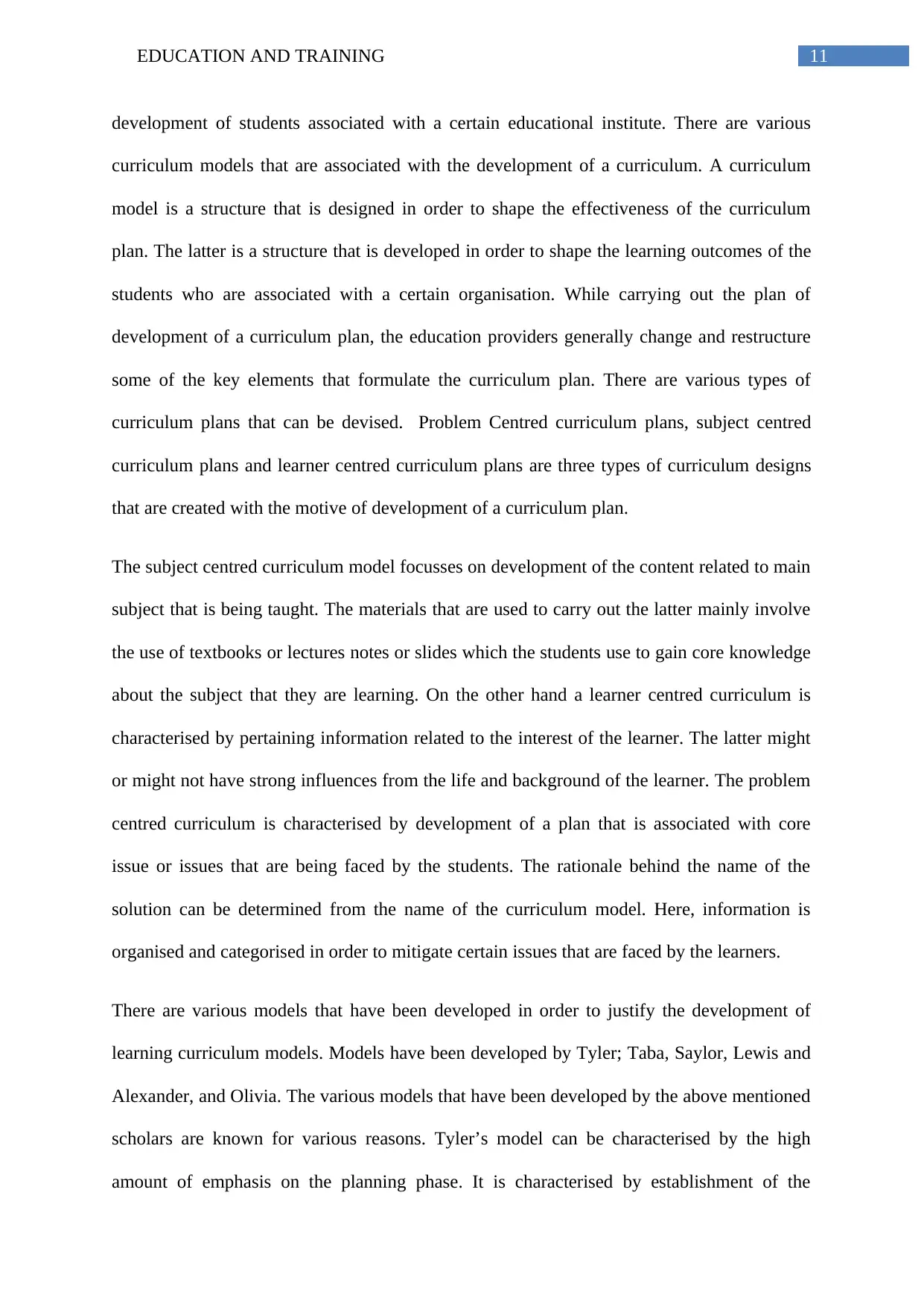
11EDUCATION AND TRAINING
development of students associated with a certain educational institute. There are various
curriculum models that are associated with the development of a curriculum. A curriculum
model is a structure that is designed in order to shape the effectiveness of the curriculum
plan. The latter is a structure that is developed in order to shape the learning outcomes of the
students who are associated with a certain organisation. While carrying out the plan of
development of a curriculum plan, the education providers generally change and restructure
some of the key elements that formulate the curriculum plan. There are various types of
curriculum plans that can be devised. Problem Centred curriculum plans, subject centred
curriculum plans and learner centred curriculum plans are three types of curriculum designs
that are created with the motive of development of a curriculum plan.
The subject centred curriculum model focusses on development of the content related to main
subject that is being taught. The materials that are used to carry out the latter mainly involve
the use of textbooks or lectures notes or slides which the students use to gain core knowledge
about the subject that they are learning. On the other hand a learner centred curriculum is
characterised by pertaining information related to the interest of the learner. The latter might
or might not have strong influences from the life and background of the learner. The problem
centred curriculum is characterised by development of a plan that is associated with core
issue or issues that are being faced by the students. The rationale behind the name of the
solution can be determined from the name of the curriculum model. Here, information is
organised and categorised in order to mitigate certain issues that are faced by the learners.
There are various models that have been developed in order to justify the development of
learning curriculum models. Models have been developed by Tyler; Taba, Saylor, Lewis and
Alexander, and Olivia. The various models that have been developed by the above mentioned
scholars are known for various reasons. Tyler’s model can be characterised by the high
amount of emphasis on the planning phase. It is characterised by establishment of the
development of students associated with a certain educational institute. There are various
curriculum models that are associated with the development of a curriculum. A curriculum
model is a structure that is designed in order to shape the effectiveness of the curriculum
plan. The latter is a structure that is developed in order to shape the learning outcomes of the
students who are associated with a certain organisation. While carrying out the plan of
development of a curriculum plan, the education providers generally change and restructure
some of the key elements that formulate the curriculum plan. There are various types of
curriculum plans that can be devised. Problem Centred curriculum plans, subject centred
curriculum plans and learner centred curriculum plans are three types of curriculum designs
that are created with the motive of development of a curriculum plan.
The subject centred curriculum model focusses on development of the content related to main
subject that is being taught. The materials that are used to carry out the latter mainly involve
the use of textbooks or lectures notes or slides which the students use to gain core knowledge
about the subject that they are learning. On the other hand a learner centred curriculum is
characterised by pertaining information related to the interest of the learner. The latter might
or might not have strong influences from the life and background of the learner. The problem
centred curriculum is characterised by development of a plan that is associated with core
issue or issues that are being faced by the students. The rationale behind the name of the
solution can be determined from the name of the curriculum model. Here, information is
organised and categorised in order to mitigate certain issues that are faced by the learners.
There are various models that have been developed in order to justify the development of
learning curriculum models. Models have been developed by Tyler; Taba, Saylor, Lewis and
Alexander, and Olivia. The various models that have been developed by the above mentioned
scholars are known for various reasons. Tyler’s model can be characterised by the high
amount of emphasis on the planning phase. It is characterised by establishment of the
⊘ This is a preview!⊘
Do you want full access?
Subscribe today to unlock all pages.

Trusted by 1+ million students worldwide
1 out of 22
Related Documents
Your All-in-One AI-Powered Toolkit for Academic Success.
+13062052269
info@desklib.com
Available 24*7 on WhatsApp / Email
![[object Object]](/_next/static/media/star-bottom.7253800d.svg)
Unlock your academic potential
Copyright © 2020–2025 A2Z Services. All Rights Reserved. Developed and managed by ZUCOL.





